The Frog and Tarantula Partnership: Why Tarantulas Keep Frogs as Pets?
The Frog and Tarantula Partnership: Why Tarantulas Keep Frogs as Pets?
By Mr Frog
 | |
| A tarantula with a dotted humming frog or a Chiasmocleis Ventrimaculata |
Picture a massive tarantula sitting in its burrow, venomous fangs poised, next to a tiny frog no larger than a coin. Rather than devouring the frog, the tarantula tolerates its presence, sometimes even seemingly “protecting” it and keeping it as a “pet.” The unusual partnership and symbiotic relationship has excited scientists and intrigued lovers of the natural world. Why would a predator partner up with a potential meal? The answer involves mutualism, a type of biological interaction in which both species profit. Let’s dig into the science behind this fascinating connection.
Mutualism: Nature’s Tug-of-War Relationship
The symbiosis between tarantulas and miniature frogs is a particularly striking form of mutualism. Accompanying this, the tarantula also creates what can be described as a sanctuary for the frog within its underground place of residence, where predators and harsh environmental conditions are kept at bay. In exchange, the frog offers the tarantula a kind of natural pest control. As an ant specialist, the frog consumes tiny insects with the potential to invade the tarantula's burrow when the tarantula is sitting on the eggs (Measey et al., 2016).
 |
| A mother spider with her spiderling and their “pet” frog |
This cross-system mutualism is a perfect start to understanding how evolutionary pressures can change species interactions. These behaviours are too persistent, suggesting that both species gain more than they lose from these interactions and are often essential to the survival strategies of both P. Herbst and its host (Martin et al., 2020).
How Tiny Frogs Help Tarantulas Survive
Tarantulas are powerful predators that typically hunt larger prey like insects and small vertebrates, but they lack the tools to fight off tiny creatures who invade their burrows, like ants. Such pests can eat tarantula eggs, posing a serious threat to the tarantula’s reproductive success. And that’s where the frogs come in.
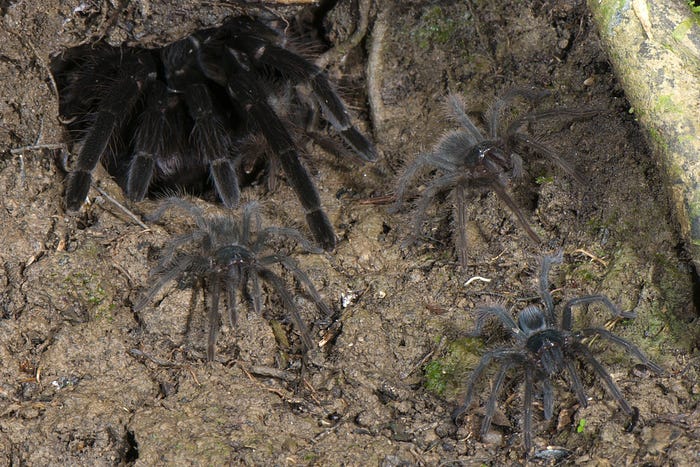 |
Microhylid frogs and Chiasmocleis Ventrimaculata, especially in the rainforests of South America, prey on small arthropods, including ants and termites. These frogs occupy the burrow of a tarantula, which serves as a natural pest controller as they devour the insects that may go on to become a danger to the tarantula’s eggs (Wikipedia, 2025). Tarantulas have also been seen as tolerant of these frogs and even teased and proposed by landing on them. Jocque and Field (2018) suggest that these behaviors indicate tarantulas can recognize their frog companions and go out of their way to avoid harming them, likely thought to have evolved due to selective pressures (e.g., the large number of (frog) eggs for a tarantula to cram into its burrow).
Why Don’t the Tarantulas Eat the Frogs?
At first, it strikes a person as odd that a predator like the tarantula doesn’t consume its diminutive amphibian roommate. One reason is an evolutionary advantage. Tarantulas that have partnered with frogs in their burrows had greater reproductive success, studies found, presumably because their eggs were better protected from pests. This behavior became normal within the tarantula population over time, establishing a mutualistic relationship (Martin et al., 2020).
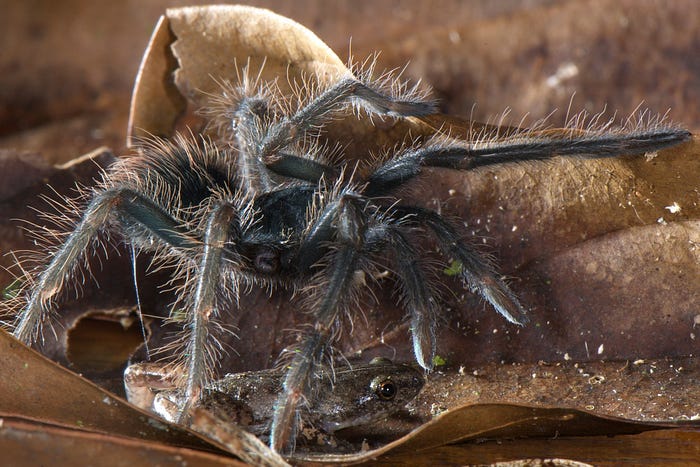 |
| A giant spider passing a frog without eating it |
From a biochemical perspective, as the frogs may also have chemical defenses that deter predators, including the tarantula, the outcome of a predation event with this spider might even be more than a simple meal for the spider. Microhylidae is one of the many families of frogs that produce toxins and secrete unpalatable chemicals through their skin. These compounds render them distasteful or even toxic to would-be predators. This is a form of chemical defense and also serves as an extra deterrent to tarantulas from thinking of the frog as a meal (Jocque & Field, 2018). Anyways, the frog is relatively small, meaning it wouldn’t be as energy-economical to eat as a bigger meal, leading the tarantula to instead pursue animals that yield more nutrition.
Frog Benefits: A Life Within a Fortress
The frog’s existence in the tarantula burrow is a classic case of a safe ecological niche.
Microhylid frogs, despite their small size, have a variety of predators, especially in tropical ecosystems that want to turn them into snacks. Some of the main animals that eat microhylid frogs include:
- Snakes: Many species of snakes, especially those found in the same environments as microhylidae, will prey on small frogs.
- Birds: Larger birds, particularly those that hunt insects or amphibians, may target microhylid frogs.
- Larger Amphibians: Some larger amphibians, such as other frogs and toads, may feed on smaller species like microhylidae.
- Mammals: Small mammals, like rodents, might also eat these frogs when they are available in their habitat.
- Fish: In aquatic environments, fish may also prey on juvenile microhylid frogs, particularly if they are still in the tadpole stage.
- Other Spiders: Not all spiders see this companion as a pet. Unlike tarantulas, they will happily eat them.
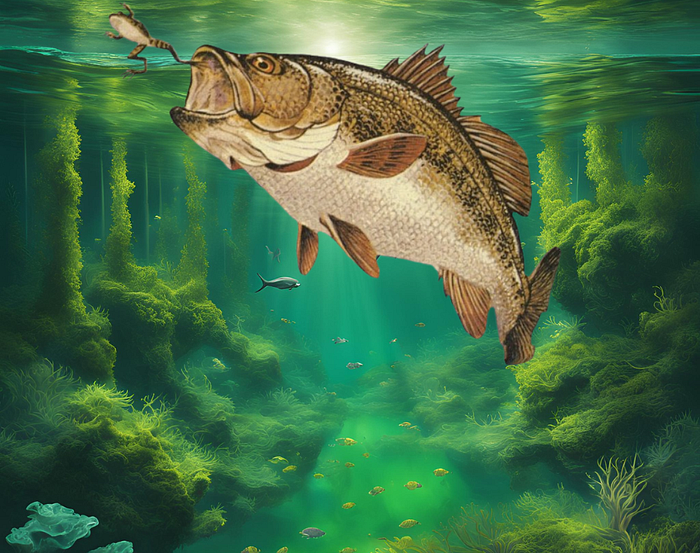 |
| Image background made with Canva Ai. Large fish was drawn by anonymous artist. The image shows a large fish attempting to eat a little frog. |
Microhylidae rely on their small size, camouflage, and the protection offered by their hiding places to evade these predators. When living alongside tarantulas, the protection provided by the tarantulas burrow may offer a safe haven, keeping these frogs safe from some of their natural predators. The size and venom of the tarantula act as a powerful deterrent to most potential threats, forming a “fortress” for the frog (Measey et al., 2016).
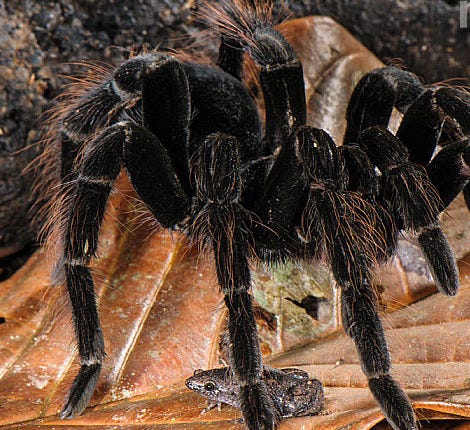 |
| Frog hiding beneath tarantula |
Additionally, the burrow serves as a microhabitat for the frog in a stable condition. These burrows tend to keep humidity levels and temperatures stable, vital for amphibians. Lacking such refuge, the frog would find it difficult to seek an appropriate environment for hydration and temperature regulation, both necessary to its physiology. So, the burrow of a tarantula gives it a physical refuge but also provides a stable microenvironment (Jocque & Field, 2018).
Of course, the other advantage for the frog is the food supply. As the tarantula hunts larger prey, it leaves behind small scraps like carcasses or pieces of dismembered insects that the frog can eat. In addition, ants and other small insects swarming into the burrow provide a steady source of food for the frog (Martin et al., 2020). An Evolutionary Origin of the Partnership |
The symbiotic relationship between tarantulas and frogs is thought to have developed in tropical habitats, including the Amazon rainforest, where the two species live together. In these regions, tarantulas often evolve against egg predators such as ants, whereas Microhylidae frogs are especially numerous and specialized in small insects, including ants (Measey et al., 2016).
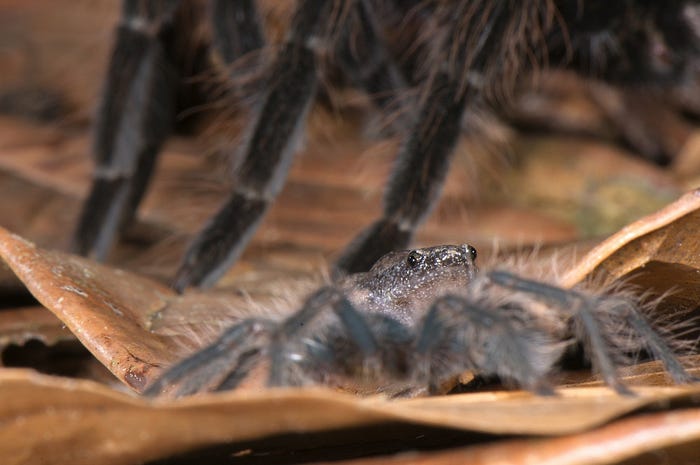 |
| These species of tarantulas lives together peacefully with a frog (Chiasmocleis ventrimaculata) |
The interaction likely developed in response to these shared ecological pressures, benefiting both species from the arrangement. Tarantulas who had frogs in their burrows experienced reduced rates of egg predation, while the frogs got to live in a safe place and have access to a steady food supply. Over time, this mutualism underwent positive feedback through natural selection, selecting the tarantulas that tolerated frogs and the frogs that occupied tarantula burrows (Martin et al., 2020).
A Different Angle: Mutualism in the Wild
This example of mutualistic interactions in nature is far from rare; it can be seen in the intimate bond between tarantulas and frogs as well. Mutualism is widespread, both in ecosystems and in surprising forms.
An example of this is a cleaner fish and certain species of sharks in which they have a mutualistic relationship where the cleaner fish eat the parasites they find on the shark’s skin, they get the nutrition from the food, and the shark gets to be healthy (Jocque & Field, 2018).
The arrangement is a familiar one in the animal kingdom: birds such as oxpeckers eat ticks and other pests that live on the mammal, while the host animal receives pest control in exchange for a free lunch.
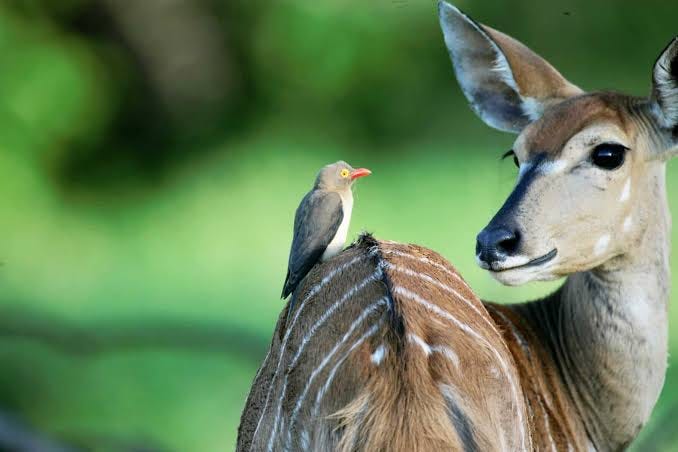 |
| An oxpecker on a nyala or spiral-horned artiodactyl antelope that is native to Southern Africa |
These examples illustrate the diversity and complexity of cooperative behavior in nature. Species develop in a co-evolutionary context, facilitating their mutual survival and the maintenance of ecosystem balance (Measey et al., 2016).
Only Certain Frogs Are Spared by Tarantulas: The Rest? A Nice Snack
In the wild, not all frogs are treated equally by tarantulas. It is only specific species, such as the microhylid frogs, that are spared and allowed to share the tarantula’s burrow. These tiny frogs, often smaller than the tarantula’s usual prey, play a key role in this mutualistic relationship. Their specialized diet of ants and small insects, which are potential threats to the tarantula’s eggs, makes them invaluable allies.
 |
| Many small tarantulas eating a dead yellow frog while sparing the small frog next to them. |
Unlike other frog species, which may not offer the same pest control benefits or could be seen as food by the tarantula, microhylid frogs are tolerated and even protected. This selective relationship highlights the delicate balance of mutualism, where both species have evolved to coexist in ways that benefit each other’s survival.
Lessons from Nature
The relationship between tarantulas and frogs is a valuable representation of nature's interdependence. And despite their size, biology, and behavioral differences, these two species have mastered the art of coexistence to their mutual benefit. Such mutualism, however, shows how cooperative powers are greater than competitive ones, and how adaptation strategies are crucial for the species to survive.
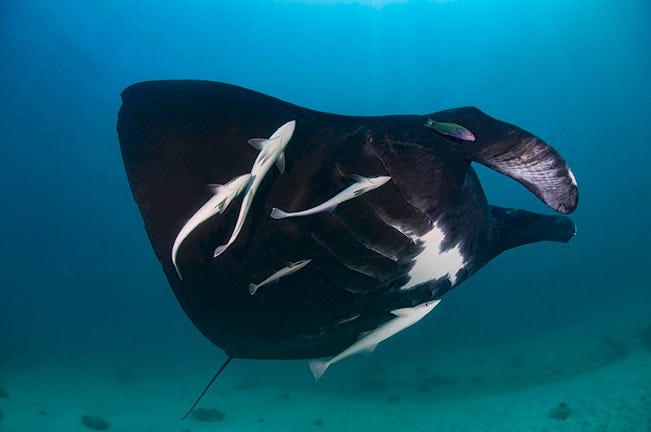 |
| Cleaner fish with a manta ray |
Studying these ecological interactions can provide valuable insights into biodiversity conservation. The evolution and maintenance of mutualistic relationships can offer valuable insights into human sustainable practices, such as quantitatively designing agricultural ecosystems based on natural partnerships to create more resistant and productive environments (Martin et al., 2020).
Conclusion
The tarantula and its minuscule frog “pet” are two perfect representations of the beauty and complexity of the natural world. Rather than a simple predator-prey dynamic, their relationship is a marvel of evolution and a standing example of how incredibly species can help one another out. As we explore more of these partnerships, they serve as reminders of the fine line that undergirds life on Earth.
So, the next time you think about tarantulas as fearsome predators, keep their tiny amphibian friends in mind and the fascinating story they can tell — a tale of survival, cooperation, and mutual benefit.
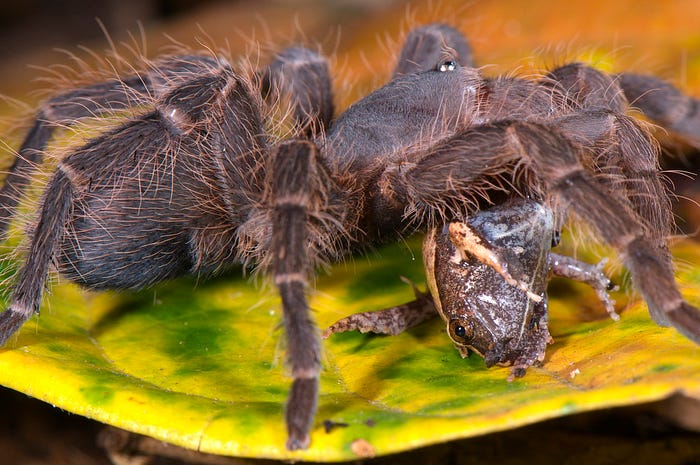 |
| However, tarantulas are still fearsome predators, in this case eating a larger treefrog |
References
- Measey, G. J., et al. (2016). Microhylid Frogs Within Tarantula Burrows Scientific Reports, 6, 30547.
- Martin, J., et al. (2020). Biodiversity Hotspots Mutualism Frontiers in Ecology and Evolution 8, 193 (2020).
- Jocque, M., & Field, D. (2018). A behavioural symbiosis across arthropods Journal of Animal Ecology 87(6): 1435–1446.
- Chiasmocleis ventrimaculata. (2025, January 2). In Wikipedia. https://en.wikipedia.org/wiki/Chiasmocleis_ventrimaculata
This is pretty nice and interesting. Frogs and Tarantulas, who would expect that? Not me
ReplyDeleteThank you 'Mr Frog' for the splendid article.
ReplyDeleteamazing article! I would LOVE to know what AI wrote this - its literally just so perfect!
ReplyDeleteThis comment has been removed by the author.
Delete